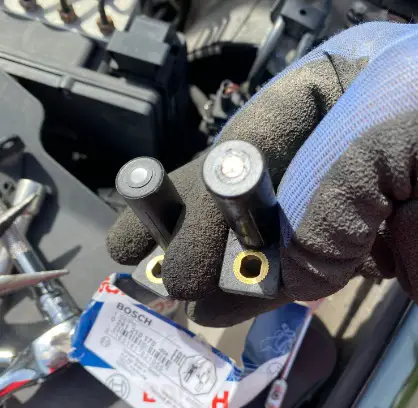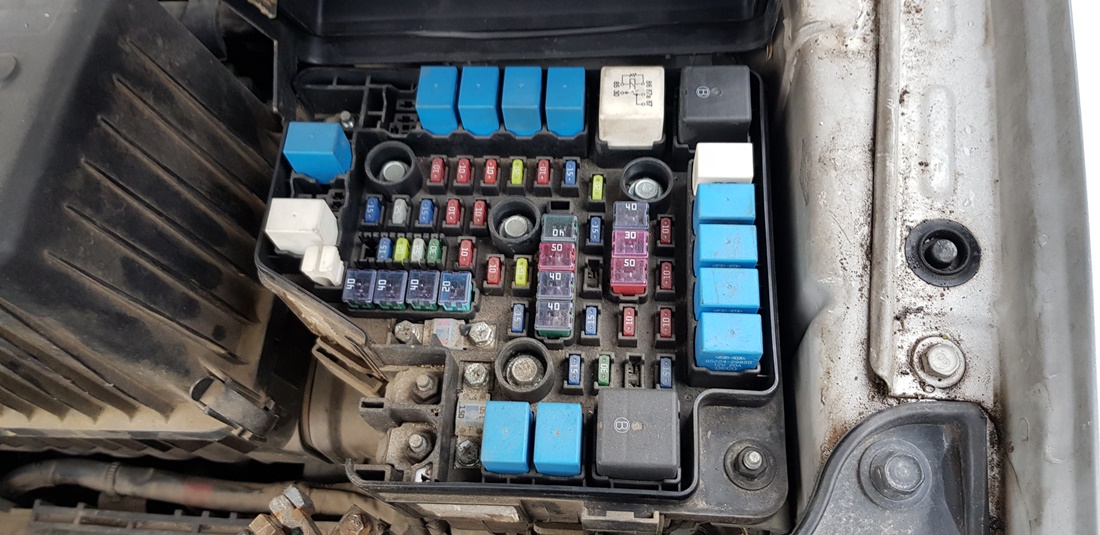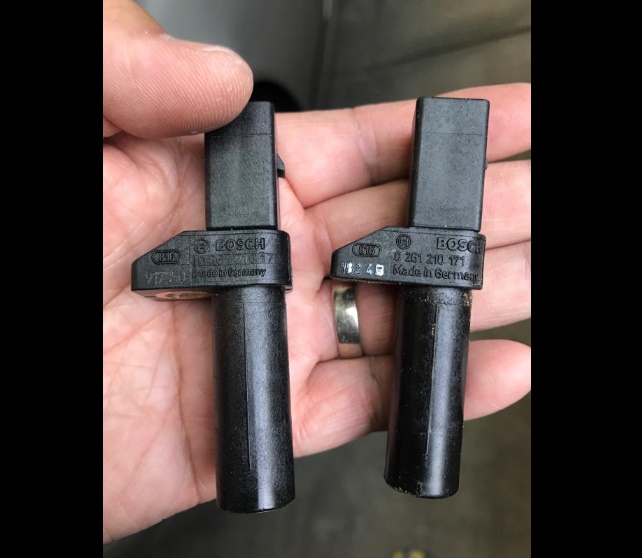Low engine oil pressure is something that needs to be taken care of immediately. When there is an issue with the oil pressure, a light gets illuminated on the dashboard.
At this point, you need to pull over your vehicle and try to find out what caused the drop in the oil pressure.
- What Is Low Engine Oil Pressure In Cars
- 14 Common Causes Of Low Engine Oil Pressure
- 1. Low Engine Oil Level
- 2. Faulty Oil Pressure Gauge/Switch
- 3. Incorrect Viscosity of The Oil
- 4. Accumulation of Dirt in The Oil Pickup Tube
- 5. Faulty Oil Pump
- 6. Oil Leak Within The Engine
- 7. Worn Out Internal Components: Main and Connecting Road Bearings
- 8. Contaminated Engine Oil
- 9. Clogged Oil Filter
- 10. Activated Engine Oil Bypass Valves
- 11. Broken or Clogged Oil Lines
- 12. Clogged Oil Suction Tube
- 13. Low-Grade Engine Oil
- 14. Weak or Leaky Oil Pressure Relief Valve
- Symptoms of Low Oil Pressure In Cars
- How Do You Diagnose Low Oil Pressure?
- Can Engine Misfire Cause Low Oil Pressure?
- Is It OK To Drive With Low Oil Pressure?
- In Conclusion
Key Takeaway
- Low engine oil pressure in cars is a condition where the oil pressure falls below the level necessary to lubricate, cool, and protect the engine’s components, potentially leading to significant damage over time.
- Common causes of low engine oil pressure include not having enough oil in the engine, using oil with incorrect viscosity, engine wear and tear, defective oil pressure gauge or pump, and the presence of dirt, debris, or sludge in the oil pick-up pipe.
What Is Low Engine Oil Pressure In Cars

Low engine oil pressure in cars is a serious issue that can lead to significant engine damage. It essentially means that there isn’t enough oil pressure to keep oil flowing to all the parts of your engine.
The oil in an engine serves as a lubricant, reducing friction between moving parts and helping to cool the engine by carrying heat away.
When the oil pressure is low, it decreases the oil’s ability to reduce friction and provide proper lubrication, causing the engine to work harder and produce more heat.
This can lead to increased wear and tear on engine components and potentially serious engine damage.
14 Common Causes Of Low Engine Oil Pressure

- Low Engine Oil Level
- Faulty Oil Pressure Gauge/Switch
- Incorrect Viscosity of The Oil
- Accumulation of Dirt in The Oil Pickup Tube
- Faulty Oil Pump
- Oil Leak Within The Engine
- Worn Out Internal Components
- Contaminated Engine Oil
- Clogged Oil Filter
- Activated Engine Oil Bypass Valves
- Broken or Clogged Oil Lines
- Clogged Oil Suction Tube
- Low-Grade Engine Oil
- Weak or Leaky Oil Pressure Relief Valve
What does engine oil pressure low mean? Low oil pressure is really bad for the engine. When the oil pressure is low, it means that the engine is not getting the needed lubrication and this can lead to serious engine damage.
Once you see the low oil pressure light illuminated, do not drive your vehicle until the issue is fixed. Here are the most common causes of low engine oil pressure:
1. Low Engine Oil Level
This might seem like a rooky mistake, but it happens a lot. Car owners often forget to check their engine oil levels.
If your engine is low on oil it can cause low engine oil pressure at idle because there won’t be a sufficient amount of oil to circulate and lubricate the engine. This can lead to serious engine damage due to a lack of lubrication.
I check my engine oil every 2 weeks. When you do so, make sure that your vehicle is parked on leveled ground and that the engine is not running for at least 10 minutes.
2. Faulty Oil Pressure Gauge/Switch
The oil pressure could be just fine, but the gauge could be displaying an incorrect reading from an incorrect signal received from the sending unit.
To find out if the oil pressure is low or why the oil pressure light is illuminated on your dashboard remove the switch and install a mechanical oil pressure gauge. If the reading is normal on the mechanical gauge, replace the switch/sender and this will solve your oil pressure problem.
3. Incorrect Viscosity of The Oil

This may appear like a no-brainer to experienced mechanics, but the first thing to make sure of is that the engine oil being used has the correct viscosity. If the oil is too thin, you will increase the risk of metal contact in between the main/rod bearings and the engine’s crankshaft.
Always follow the recommendation made by the manufacturer. As the engine increases in mileage, for example over 150,000 miles and beyond, you can increase the viscosity slightly. If your engine required 5W-30 when it was new, you can now use 10W-30.
4. Accumulation of Dirt in The Oil Pickup Tube
This is one of the most common causes of low engine oil pressure. Sludge will clog the oil pick-up tube, therefore, restricting oil flow to the engine. Sludge is created when the engine oil starts breaking down due to heat and friction. Plus, the accumulation of deposits collected from combustion gases made it past the piston rings.
5. Faulty Oil Pump
Another common cause of low oil pressure is excessive clearances inside the oil pump. The exact specification may vary, but there is a general rule that the oil pumps should have less than 0.003 inches of space between the gears and cover and 0.005 inches of clearance between the teeth and pump housing.
With rotor-style pumps, the clearance between the outer rotor and pump housing should usually be less than 0.012 inches, with no more than about 0.010 inches between the inner and outer rotor lobes. Too much clearance inside the pump will reduce the pump’s ability to pump oil efficiently which reduces the flow and pressure says Lube Zone.
6. Oil Leak Within The Engine
A loss of engine oil can cause low oil pressure. The engine lubrication is a closed circuit and any cracks or leaks within the oil passages will affect the oil circulation.
If the oil leaks due to a cracked line or worn piston rings, it leaves the system and there is just not enough oil left to lubricate the engine making sure that it is operating correctly.
7. Worn Out Internal Components: Main and Connecting Road Bearings
High engine speeds can cause faster than normal wear on crankshaft bearings, especially if combined with low-quality engine oils and longer than specified intervals in between oil changes.
Excessive bearing clearances (more than about .001 inch per inch of diameter of the crankshaft journal) can cause up to a 20 percent or greater drop in oil pressure, which may in turn have an adverse effect on lubrication elsewhere in the engine (such as the camshaft and upper valve train, especially in overhead cam engines).
Having low oil pressure may result in problems with overhead cam engines with variable valve timing clearances. It’s not how these excessive clearances appear, the results are exactly the same.
Excessive bearing clearances will also increase engine noise and pounding, which over time can lead to bearing fatigue and failure.
8. Contaminated Engine Oil
Engine oil contamination is something that doesn’t happen very often, but when it does, it can cause low oil pressure.
The engine oil gets mixed with the fuel or coolant due to internal engine cracks or faulty seals and when it does, it is not thing its main function which is to lubricate the engine components.
Decreased engine lubrication can lead to a huge repair bill. If you are noticing that you are low on engine oil, but can’t seem to find any oil underneath your vehicle, take your vehicle to the mechanic because the issue could be internal.
9. Clogged Oil Filter

A clogged oil filter can be another cause of low oil pressure. As soon as the oil leaves the oil pump, it goes to the oil filter before reaching the bearings and oil galleys.
All oil filters are creating some level of oil resistance flow. But the amount is not much, typically only a couple of pounds.
But as the oil filter becomes clogged with debris, the oil restriction increases. This may reach a point where zero oil can pass through the filter.
As a safety switch, the engine has a pressure relief valve located on the filter or where the filter mounts to the engine. But, that causes another set of problems.
10. Activated Engine Oil Bypass Valves
When the oil bypass valves are activated, the oil pressure will drop. As I said before, the oil filter can get clogged to a point where no oil can pass through it.
To prevent critical blockage, oil filters have a pressure relief valve installed which has a main function to open if the pressure is very high (typically 5 to 40 psi).
This allows the oil to bypass the filter and keep on flowing. But the engine oil pressure will be reduced to the capacity of the bypass valve.
11. Broken or Clogged Oil Lines
If an oil line is clogged or broken the engine flow will decrease significantly and therefore the oil pressure will drop.
The oil passes through a lot of small oil lines which over time can get clogged or broken. If this is the case, you need to get your vehicle to the mechanic shop and the engine builder needs to check every single oil line and passage for leaks.
Replacing or fixing an oil line isn’t very expensive, but the damage it can cause if not treated is huge. Remember, if the engine is not getting enough lubrication, it can overheat and you will be looking at a huge repair or engine replacement.
12. Clogged Oil Suction Tube
The oil suction tube has an inlet screen that often gets clogged or damaged. A clogged or damaged oil suction tube can cause low oil pressure because the oil flow is either restricted or leaking.
You would need to check the inlet screen and remove any buildup that could be restricting oil flow. Sometimes the issue could be because the suction tube is not installed properly and instead of oil, it is sucking air.
13. Low-Grade Engine Oil

Using low-grade engine oil and increasing the length of time and mileage in between oil changes will increase the risk of sludge being generated inside your engine causing low oil pressure and premature engine wear and failure.
To avoid this from happening make sure to use good quality engine oils that either meet or exceed the engine manufacturer’s recommendations.
Most importantly, don’t go past the oil change intervals. The cost of frequent oil changes is cheaper than replacing an engine that failed due to poor lubrication and sludge. You could save a couple of dollars on an oil change. But, it could lead you to a $5000 bill for an engine change.
14. Weak or Leaky Oil Pressure Relief Valve
Some oil pumps also have an oil pressure relief valve. Some engines may have it on the engine block.
A weak or leaky oil pressure relief valve is one of the most common causes of low engine oil pressure and happens if the valve sticks open or is held open by a small piece of debris/sludge.
The relief valve is designed to limit oil pressure as engine speed increases. The valve opens when the pressure reaches a preset valve (typically 40 to 60 psi).
This vents oil back into the crankcase and limits maximum oil pressure in the engine. Too much oil pressure can be just as bad as too little. This is because excessive pressure can rupture the oil filter or even blow out pressed-in oil galley plugs in the block.
Symptoms of Low Oil Pressure In Cars
- Oil Pressure Warning Light: This is usually the first sign of low oil pressure. The warning light on your dashboard will illuminate when the oil pressure drops below a certain level.
- Unusual Engine Noise: If you hear tapping, knocking, or rattling sounds, it could indicate low oil pressure.
- Decreased Engine Performance: The car might not accelerate as quickly, or it may sputter or stall.
- Overheating Engine: Low oil pressure can lead to increased friction and consequently overheating.
- Smell of Burning Oil: If the oil isn’t circulating properly, it can cause parts of the engine to overheat and burn the oil, creating a noticeable smell.
- Decreased Oil Level: If your oil level is constantly low, it may be a sign of low oil pressure.
- Smoke from the Exhaust Pipe: Excessive smoke from the exhaust pipe can be an indication of low oil pressure.
How Do You Diagnose Low Oil Pressure?
- Check the Oil Level: The first step is to check if there’s enough oil in the engine. This can be done using the dipstick.
- Check the Oil Pressure Sensor: The sensor could be faulty and give an inaccurate reading. You can use an oil pressure gauge to verify.
- Inspect the Oil Filter: A clogged oil filter can cause low oil pressure. If the filter is dirty, consider replacing it.
- Examine the Oil Pump: A failing oil pump can lead to low oil pressure. Listen for any unusual noises that might indicate a problem.
- Assess the Engine Oil Viscosity: Use the correct oil viscosity as recommended by your vehicle’s manufacturer. Too thick or too thin oil can cause low oil pressure.
- Look for Oil Leaks: Check for any visible signs of oil leaks in your engine.
- Check the Oil Pressure Relief Valve: If the valve is stuck open, this can cause low oil pressure. It may need cleaning or replacing.
- Inspect Internal Engine Components: Worn-out bearings or other internal engine parts can cause low oil pressure. This usually needs professional assessment.
How To Fix Low Oil Pressure In a Car
- Check Oil Levels: The first step is to check your oil levels using the dipstick. If the oil level is lower than it should be, add more oil until it reaches the recommended level.
- Check Oil Quality: Look at the color and consistency of the oil on the dipstick. If it’s dark and dirty, it may be time for an oil change.
- Change Oil Filter: A clogged oil filter can cause low oil pressure. Replace the filter and see if that solves the problem.
- Inspect Oil Pump: The oil pump circulates oil throughout the engine. If it’s damaged or not working properly, it could be causing low oil pressure. You may need a mechanic to inspect and potentially replace the pump.
- Look for Oil Leaks: If your car is leaking oil, it could lead to low oil pressure. Check under the car for any signs of oil leaks and have them repaired.
- Check Engine for Damage: If all else fails, there could be damage within the engine causing the low oil pressure. This would require a professional mechanic to diagnose and repair.
Can Engine Misfire Cause Low Oil Pressure?
There is a relation between engine misfire and low oil pressure because the sudden drop of oil pressure can cause the engine not to run right and the RPMs to drop low in gear causing an engine misfire.
A common cause of misfire can be oil in the spark plug and the oil could get there if there is an engine oil leak which will cause low oil pressure too.
Fixing the oil leak will fix the oil pressure issue. This will return the engine to normal operating behavior and the misfire will stop.
Is It OK To Drive With Low Oil Pressure?
No, it is not safe to drive with low oil pressure. The oil in your vehicle serves a critical function – it lubricates the engine’s internal components, reduces friction, and helps to cool the engine.
Low oil pressure means that there isn’t enough oil flowing inside the engine to perform these tasks properly, which can lead to increased wear and tear on the engine parts and potential overheating.
Driving with low oil pressure can cause serious, sometimes irreparable damage to your vehicle’s engine.
If the oil pressure is too low, the engine may not get the lubrication it needs, leading to increased friction between its moving parts.
This can eventually cause the engine to seize up, which can be a very costly problem to fix.
FAQs
Q: How does a malfunctioning oil pump affect the engine oil pressure?
A: A malfunctioning oil pump may not be able to circulate the oil properly, resulting in low oil pressure. This can lead to inadequate lubrication of engine components and potential engine damage.
Q: Can low engine oil level cause low oil pressure?
A: Yes, if the engine oil level is too low, there may not be enough oil to maintain proper pressure. It is important to regularly check and maintain the recommended oil level to prevent low oil pressure.
Q: Are oil leaks a common cause of low engine oil pressure?
A: Yes, oil leaks can lead to low oil pressure. If there are any leaks in the oil system, such as from gaskets, seals, or hoses, the oil level may drop and result in low pressure.
Q: How does a clogged oil filter affect oil pressure?
A: A clogged oil filter can restrict the flow of oil, causing a drop in oil pressure. This can happen if the filter becomes clogged with debris or dirt, hindering the smooth circulation of oil through the engine.
Q: What are the signs of low engine oil pressure?
A: Signs of low oil pressure may include illuminated warning lights on the dashboard, engine knocking or ticking noises, decreased power or performance, and overheating of the engine.
Q: Can using the wrong grade of oil result in low oil pressure?
A: Yes, using the wrong grade of oil can affect the oil pressure. Different engines require specific oil viscosities, and using oil with a viscosity that is too high or too low for the engine can lead to low oil pressure.
Q: How frequently should I check my engine oil level?
A: It is recommended to check your engine oil level at least once a month or before any long trips. Regular oil level checks can help identify any potential issues and prevent low oil pressure.
Q: Can a faulty oil pressure sensor give false readings of low oil pressure?
A: Yes, a faulty oil pressure sensor can give false readings of low oil pressure. It is important to have the sensor inspected and replaced if necessary to ensure accurate oil pressure readings.
Q: What should I do if I notice low engine oil pressure?
A: If you notice low engine oil pressure, it is crucial to stop driving your vehicle immediately and check the oil level. If the oil level is low, add the recommended oil. If the problem persists, consult a professional mechanic to diagnose and repair any underlying issues.
In Conclusion
Low engine oil pressure is a serious issue that can lead to significant damage to your vehicle’s engine.
The causes can range from low oil levels, faulty oil pressure sensors, incorrect oil viscosity, clogged oil filters, and defective oil pumps to worn-out internal engine components.
Symptoms of low oil pressure are often noticeable and include an illuminated oil pressure warning light, unusual engine noises, decreased engine performance, and the smell of burning oil. It’s crucial to address these symptoms immediately to prevent further damage.
Regular maintenance, using the correct grade of oil, and paying attention to your car’s warning signs can help prevent low oil pressure scenarios.




